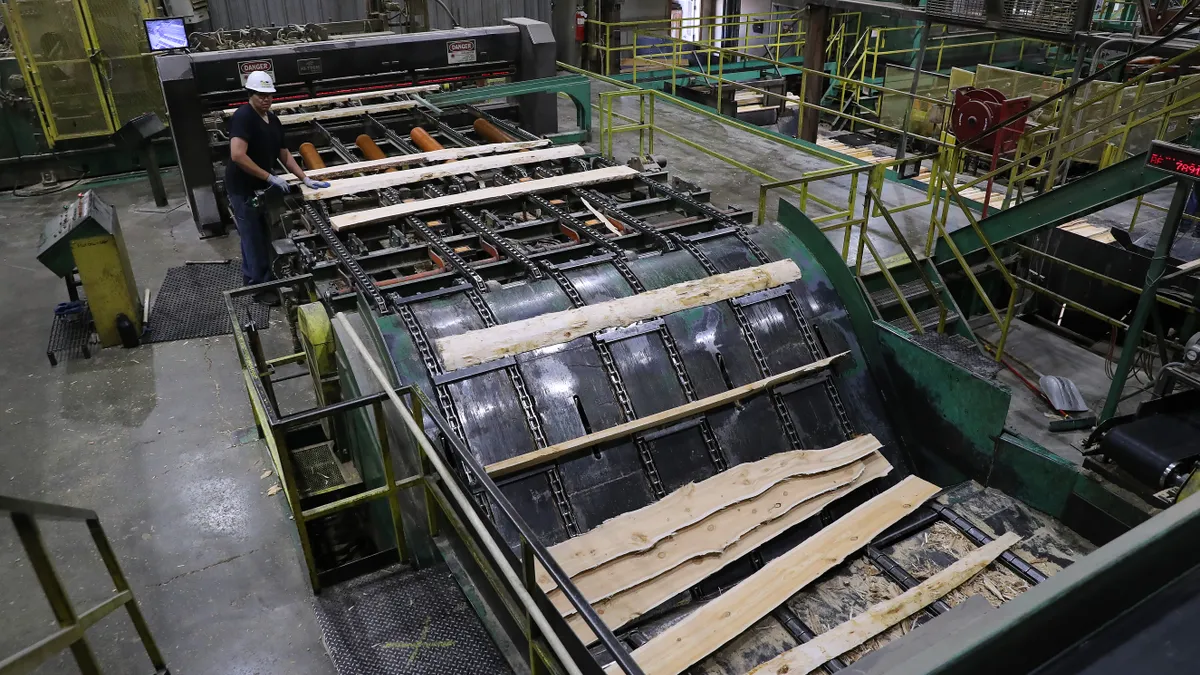If a tree falls in the woods, how much is it worth? Right now, in a market with a lumber shortage, a lot.
Lumber prices have spiked this year. Lumber futures contracts for May delivery hit $1,645 per 1,000 board feet, up from about 60% a month ago, and 374% over the last year, reports Wells Fargo. It's the fastest rise since the post-World War II housing boom, according to Mark Vitner, managing director and senior economist at Wells Fargo.
"The demand for lumber is exceptionally high and the supply is constrained," Vitner said. As recently as Friday, the cash price was $1,514 per thousand board feet.
That hit home building hard. The National Association of Home Builders reported that lumber costs are adding an average of $36,000 to new single family home prices. Those prices have also added $12,966 to the value of an average new multifamily home. As those are typically built to rent, that in turn is adding $119 a month in rent to new apartments.
Prices are also affecting smaller remodeling jobs, for consumers who can find materials. "We don't see a lot of capacity coming online, so we're probably not going to see a lot of finished lumber product in distribution, so as soon as that product hits our stores, it sells," Craig Menear, Home Depot CEO, said in the company's May earnings call.
Supply constraints on lumber are not new
"It's a mess," said Vitner, and one that didn't start with the pandemic but with the Great Recession of 2008-2009. When the housing market went bust, at least 30 large sawmills closed for good, according to the U.S. Forest Service.
The 2017 tariffs on Canadian softwood lumber also added to overall lumber costs, plus wildfires in the Pacific Northwest wiped out potential stock, said Vitner, and these trees can also take a decade or more to grow to harvestable size.
Lumber prices surge
Then COVID closed or limited sawmills at the start of the pandemic. "Everyone that was in charge of lumber and mills are saying 'okay we're going to shut down and there's not going to be a great demand,'" said John Bell, associate professor of supply chain management at the University of Tennessee Knoxville. "So you flush all the inventory out of the system."
Millions of people staying home increased the demand for lumber. Spending so much time in one place for work/and or school had people rethinking their homes, which surged the demand for renovations for more space, or bigger homes for more space, especially for city folks who decided to become country mice.
The median existing-home sales price in March 2021 jumped by a "record breaking" 17.2% to $329,110, according to the National Association of Realtors. At the same time, by the end of March, housing inventory slightly rose to 1.07 million units but was still down by 28.2% year-over-year.
That pushed the need to build new homes, and lumber, shooting prices to the moon. "There's been an unprecedented shift in the housing market, trying to build these new homes," Bell said. "This is straight up economics. When demand and supply are imbalanced, price goes up."
How lumber supply crashed into demand
It doesn't make much sense for those sawmills shuttered by theGreat Recession to reopen, said Vitner, not only because that takes time and money, but also because there isn't enough labor to work the sawmills that are open at full capacity. A truck driver shortage, plus higher diesel fuel prices, also mean that it's less profitable for timber owners to ship logs to sawmills.
The overall labor shortage can be attributed in part to expanded unemployment benefits, said Vitner, but also because a second round of stimulus hit around the same time as tax refunds. Plus, he suspects, workers wanted to be fully vaccinated before coming back on the job.
The best buyers of lumber can do, whether that's a home builder or Mr. Fix It, is wait to start new projects, or pay up.
New home starts for single-family homes dropped by more than 13% in April compared to March, the biggest drop since the start of the pandemic, according to the U.S. Census Bureau. For those still moving ahead, they are trying to protect themselves too, with 22% of builders getting price guarantees from suppliers, and 47% adding price escalation clauses to sales contracts, according to the National Association of Home Builders.
Bringing lumber prices back to earth
Vitner, who has put off building a garage, said that he expects the labor part of the sawmill problem to start resolving itself later this year but expects prices to remain high into 2022.
That lines up with what a wholesale lumber distributor and former lumber trader told CNBC. Analyzing seven bullish cycles over more than three decades shows cycles lasting as short as nine months and as long as 41 months, Sherwood Lumber COO Kevin Little said. This current cycle is in its eleventh month.
Sourcing wood from Canada is also problematic. The U.S. Commerce Department lowered tariffs on Canadian Lumber to 9% from 20% in December. Vitner said that nixing them entirely could help but Canada has had its own supply issues due to the mountain pine beetle, which destroyed about nine million single-family homes worth of lumber supply in British Columbia, Alberta and the Pacific Northwest, according to Bloomberg.
But no matter what changes in labor, and tariffs, prices will stay high "as long as people keep showing up and paying millions of dollars" for lumber, said Bell.
This story was first published in our weekly newsletter, Supply Chain Dive: Procurement. Sign up here.






















